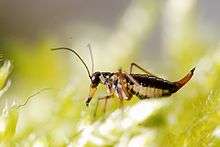Snow scorpionfly
Boreidae, commonly called snow scorpionflies, or in the British Isles, snow fleas (no relation to the snow flea Hypogastrura nivicola) are a very small family of scorpionflies, containing only around 30 species, all of which are boreal or high-altitude species in the Northern Hemisphere. Recent research indicates the boreids are more closely related to fleas than to other scorpionflies, which renders the order Mecoptera paraphyletic if the order Siphonaptera is excluded from it.[1]
| Snow scorpionfly | |
|---|---|
 | |
| Boreus hiemalis | |
| Scientific classification | |
| Kingdom: | Animalia |
| Phylum: | Arthropoda |
| Class: | Insecta |
| Order: | Mecoptera |
| Family: | Boreidae |
| Genera | |
These insects are small (typically 6 mm or less), with the wings reduced to bristles or absent, and they are somewhat compressed, so in fact some resemblance to fleas is noted. They are most commonly active during the winter months, towards the transition into spring, and the larvae and adults typically feed on mosses. The adults will often disperse between breeding areas by walking across the open snow, thus the common name. The males use their bristle-like wings to help grasp the female over his back while mating, while the wings of females are vestigial small oval pads with no ability to allow her to fly. The adults have a long rostrum formed from the clypeus and labrum, genae, and maxillo-labium.
The body temperature, and therefore activity level, of this scorpionfly depends on its absorption of short-wave and long-wave radiation rather than surrounding air temperatures (by which it is completely unaffected). The boundary layer of snow that the insect occupies has very low thermal conductance, and so the insect loses its own heat very slowly here. This delicate balance between cold and heat means that the animal is easily killed by heat when held in a human hand.[2]
Phylogeny
The cladogram of external relationships, based on a 2008 DNA and protein analysis, shows the family as a clade, sister to the Siphonaptera, and more distantly related to the Diptera (true flies) and Mecoptera (scorpionflies).[3][4][5][6]
| part of Endopterygota |
| ||||||||||||||||||||||||||||||||||||
Genera
This list is adapted from the World Checklist of extant Mecoptera species,[7] and is complete as of 1997. The number of species in each genus is indicated in parentheses.
- Boreus (24) Latreille, 1816 (North America, Europe, Asia)
- Boreus hyemalis - also called the snow flea.
- Caurinus (2) Russell, 1979 (Oregon, Alaska)[8]
- Hesperoboreus (2) Penny, 1977 (USA)
See also
- Glacier flea
- Snow flies genus Chionea - a convergent genus of wingless crane flies
- Apteropanorpidae - another family of wingless scorpionflies
References
- Whiting, M. F. (2002). "Mecoptera is paraphyletic: multiple genes and phylogeny of Mecoptera and Siphonaptera". Zoologica Scripta. 31 (1): 93–104. doi:10.1046/j.0300-3256.2001.00095.x.
- Daniel Marlos (2010-10-05). The Curious World of Bugs: The Bugman's Guide to the Mysterious and Remarkable Lives of Things That Crawl. Penguin Publishing Group. p. 218. ISBN 978-1-101-44406-1.
- Whiting, Michael F.; Whiting, Alison S.; Hastriter, Michael W.; Dittmar, Katharina (2008). "A molecular phylogeny of fleas (Insecta: Siphonaptera): origins and host associations". Cladistics. 24 (5): 677–707. CiteSeerX 10.1.1.731.5211. doi:10.1111/j.1096-0031.2008.00211.x.
- Yeates, David K.; Wiegmann, Brian. "Endopterygota Insects with complete metamorphosis". Tree of Life. Retrieved 24 May 2016.
- Whiting, Michael F. (2002). "Mecoptera is paraphyletic: multiple genes and phylogeny of Mecoptera and Siphonaptera". Zoologica Scripta. 31 (1): 93–104. doi:10.1046/j.0300-3256.2001.00095.x. Archived from the original on 2013-01-05.
- Wiegmann, Brian; Yeates, David K. (2012). The Evolutionary Biology of Flies. Columbia University Press. p. 5. ISBN 978-0-231-50170-5.
- Boreidae Archived 2004-01-11 at Archive.today
- Sikes, Derek; Jill Stockbridge (July 11, 2013). "Description of Caurinus tlagu, new species, from Prince of Wales Island, Alaska (Mecoptera, Boreidae, Caurininae)". ZooKeys (316): 35–53. doi:10.3897/zookeys.316.5400. PMC 3713333. PMID 23878513.





